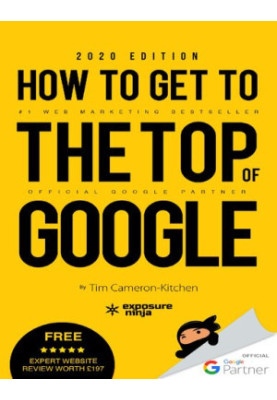How To Get To The Top Of Google in 2020: The Plain English Guide to SEO
 Instant download
Instant download
after payment (24/7)
 Wide range of formats
Wide range of formats
(for all gadgets)
 Full book
Full book
(including for Apple and Android)
Become one of the 10,000+ business owners and marketers who have used this bestselling no-nonsense SEO book to increase their rankings and sell more.Whether you’ve dabbled in Search Engine Optimisation (SEO) and been disappointed with the results, are a complete SEO newbie looking for a large slice of the ranking pie or you’re a seasoned professional looking to stay up to date with the best SEO practices, this book is for you.How would it feel to…Understand how Google chooses which websites to rank?Know exactly what keywords to target to attract people who are ready to buy what you sell?Have your most profitable keywords hit the top spot?Confidently be able to tweak your website and its structure (no technical know-how needed!) for fast gains?Be able to write killer content that Google and your visitors love?Build relationships with key publication players in your industry and have them begging for your content?Have crafted a complete SEO strategy to laser-target your focus and get big results?What kind of results can you achieve?One of our clients came to us in 2015 asking for help. His business was making $2k per month in sales, and he was contemplating closing shop. Today, that business turns over $3.4million per month, thanks to the strategies in this book.You’ll read about this business and others in the book. Every strategy is data-backed and battle-tested by the Exposure Ninja team, who grow real businesses like yours.A free gift before we begin…How Easy Is It To Rank?How to Use This BookThe Structure of this BookThis Book is Not Written By an AuthorSection 1: The FoundationsChapter 1: Four free ways to appear on the first page of GoogleMethod 1: Google Organic ResultsMethod 2: Featured SnippetsMethod 3: Google LocalMethod 4: Using Other People’s WebsitesChapter 2: How Google decides where to rank you and your competitorsRanking Pillar 1: RelevanceHow Does Google Measure Relevance?Myth Buster: IndexingRanking Pillar 2: Popularity and AuthorityRanking Pillar 3: QualityUpgrade 1: Your Website’s ContentUpgrade 2: Errors and Broken LinksUpgrade 3: Mobile FriendlinessChapter 3: How to find and rank for the most profitable keywordsStep 1. Brainstorm keywordsStep 2. Download keywords from Search ConsoleStep 3. Use SEMrush to find keywordsStep 4. Check competitor keywordsStep 5. If you’re a location-based business…Step 6. Find your most profitable keywordsStep 7. Google keywords to check the search results are relevantStep 8. Now you’ve got your keywords, find your key pagesA final word about keyword researchChapter 4: Analysing your competition and identifying their strengths and weaknessesPRO TIP: Checking RankingDeconstructing Your Competitors’ SuccessChapter 5: An Introduction to backlinksAnchor TextSection 2: Your WebsiteChapter 6: Website OptimisationChapter 7: Domains and URLsKey EMD MythsDifferences between TLDsHyphens and SeparatorsDomain LengthDomain AgeCapital LettersPage URLsCapital LettersChapter 8: How to structure a top-ranking websiteFolders and DirectoriesUse Separate Pages for Each ServiceChapter 9: SitemapsChapter 10: One website or multiple?Chapter 11: Website usability and performanceChapter 12: MobileMobile FriendlinessResponsive Websites vs Separate Mobile WebsitesChapter 13: How to write for Google and profitWhat Is Good Content?Spelling. And Grammer.Duplicate ContentWhere a Site Can Be Penalised for Duplicate ContentHeadingsContent for eCommerce (or Other Large Websites)Chapter 14: How To Use Knowledge Bases and FAQs To 10X Your Organic TrafficHow to Plan a Knowledge BaseChapter 15: How to use your blog to actually make moneyFurther ResourcesChapter 16: Behind the scenes optimisationThe Fastest Way To Improve Your Ranking: Writing Killer Page TitlesMeta DescriptionsMeta KeywordsImage OptimisationSchema MarkupChapter 17: Website speed hacksMobile Site SpeedHuman Response Times: The 3 Important LimitsMeasuring Your Website’s PerformanceChapter 18: Google Search ConsoleManual Actions and Reconsideration RequestsSection 3: Promoting Your WebsiteChapter 19: Link acquisition basicsChapter 20: Good links vs bad linksAre you suffering from a link penalty?Link MetricsDomain Authority (DA)Page Authority (PA)Trust Flow (TF)Citation Flow (CF)How to Use These MetricsChapter 21: Online directoriesMarket-Specific Directories vs General DirectoriesHow To Spot a Spammy DirectoryChapter 22: Links from videoChapter 23: Introduction to content marketingChapter 24: How to get featured on the world’s biggest websites through digital PRUsing PR For Free Advertising/Lead GenerationPitching for TV CoverageFollowing Up Journalists and EditorsChapter 25: 95% of surveys are run by businesses looking for PReCommerce Data Outreach ExampleLead Generation Data OutreachHow To Run Your Own Data Outreach StudyChapter 26: Blogger and influencer outreachChapter 27: How to get influencers to promote your businessHow to pitch to influencers without feeling awkwardChapter 28: How to use Inbound PR requests to get featured in top-tier publications… freeHow To Do All Of This Without Paying For Journalist Enquiry ServicesChapter 29: Using social media to boost your SEOOptimise Your Social ProfilesHow to Get Your Business Showing Up as an Expanded Listing on GoogleOptimising Your Facebook PageHow to Get Lots of Reviews on Facebook and GoogleSection 4: Designing and Implementing your SEO StrategyChapter 30: How to plan an SEO strategyStep 1: Website ReviewStep 2: Keyword TargetingStep 3: Competitor AnalysisStep 4: Website OptimisationStep 5: Phase 1 LinksStep 6: Phase 2 LinksStep 7: Measure Progress and RefocusChapter 31: How to measure your progressHow to measure how many keywords your website is ranking forHow to measure and track the most relevant keywordsChapter 32: Outsourcing vs DIYChapter 33: Further help and advice
LF/934372/R
Data sheet
- Name of the Author
- Andrew
Cameron-Kitchen
Dale
Davies
Tim
Tuxford - Language
- English
- Release date
- 2020













